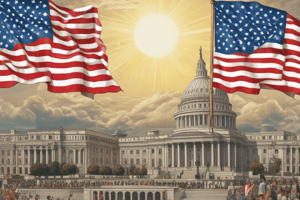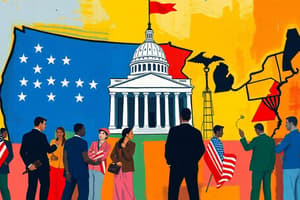Podcast
Questions and Answers
How does the system of checks and balances function within the U.S. government?
How does the system of checks and balances function within the U.S. government?
- It streamlines the legislative process by removing obstacles to passing laws.
- It promotes absolute autonomy for each branch, fostering independent decision-making.
- It centralizes power within the executive branch, allowing for quicker responses to national crises.
- It ensures that no single branch of government becomes too dominant by allowing each branch to limit the power of the others. (correct)
What is the significance of the Tenth Amendment?
What is the significance of the Tenth Amendment?
- It outlines the specific powers granted to the federal government.
- It defines the rights of individual citizens, protecting them from government overreach.
- It reserves powers not delegated to the federal government to the states, promoting the idea of state sovereignty. (correct)
- It establishes the supremacy of federal laws over state laws in all matters.
What is the critical threshold for ratification of a proposed amendment by state legislatures?
What is the critical threshold for ratification of a proposed amendment by state legislatures?
- A unanimous vote by all state legislatures.
- Two-thirds of the state legislatures.
- Three-fourths of the state legislatures. (correct)
- A simple majority of state legislatures.
What is the function of enumerated powers?
What is the function of enumerated powers?
What was the main argument in Federalist 78, authored by Alexander Hamilton?
What was the main argument in Federalist 78, authored by Alexander Hamilton?
In the context of the U.S. Constitution, what does the 'Necessary and Proper Clause' enable Congress to do?
In the context of the U.S. Constitution, what does the 'Necessary and Proper Clause' enable Congress to do?
What principle was reinforced by the 1819 Supreme Court case McCulloch v. Maryland?
What principle was reinforced by the 1819 Supreme Court case McCulloch v. Maryland?
What key aspect of the Great Compromise resolved a significant issue during the Constitutional Convention?
What key aspect of the Great Compromise resolved a significant issue during the Constitutional Convention?
What did the Federalists advocate for during the period of the Constitution's creation?
What did the Federalists advocate for during the period of the Constitution's creation?
What was the main concern of the Anti-Federalists regarding the newly proposed Constitution?
What was the main concern of the Anti-Federalists regarding the newly proposed Constitution?
In what fundamental way did John Locke influence the Declaration of Independence?
In what fundamental way did John Locke influence the Declaration of Independence?
What critical weakness of the Articles of Confederation was highlighted by Shays' Rebellion?
What critical weakness of the Articles of Confederation was highlighted by Shays' Rebellion?
What fundamental principle underlies the concept of 'popular sovereignty'?
What fundamental principle underlies the concept of 'popular sovereignty'?
What is the core idea behind republicanism as a form of government?
What is the core idea behind republicanism as a form of government?
Which type of democracy emphasizes broad participation in politics and civil society?
Which type of democracy emphasizes broad participation in politics and civil society?
How does pluralist democracy function?
How does pluralist democracy function?
What viewpoint did the Anti-Federalists have regarding state and local governments?
What viewpoint did the Anti-Federalists have regarding state and local governments?
What is the purpose of "grants", distributed by the federal government?
What is the purpose of "grants", distributed by the federal government?
What is the main responsibility of state and local judiciary bodies?
What is the main responsibility of state and local judiciary bodies?
What is not considered a delegated power belonging to the federal government?
What is not considered a delegated power belonging to the federal government?
Flashcards
Delegated Powers
Delegated Powers
Powers belonging to the federal government, such as international treaties.
Reserved powers
Reserved powers
Powers belonging to the states, per the 10th Amendment.
Concurrent powers
Concurrent powers
Powers shared by both state and federal governments.
Denying power
Denying power
Signup and view all the flashcards
Fed Gov Programs
Fed Gov Programs
Signup and view all the flashcards
Grants
Grants
Signup and view all the flashcards
Separation of Powers
Separation of Powers
Signup and view all the flashcards
System of Checks and Balances
System of Checks and Balances
Signup and view all the flashcards
Amendment process
Amendment process
Signup and view all the flashcards
Fed 51
Fed 51
Signup and view all the flashcards
Fed 70
Fed 70
Signup and view all the flashcards
Fed 78
Fed 78
Signup and view all the flashcards
Constitution
Constitution
Signup and view all the flashcards
Proper Clause
Proper Clause
Signup and view all the flashcards
Federalism
Federalism
Signup and view all the flashcards
United States v. Lopez
United States v. Lopez
Signup and view all the flashcards
Madison's Virginia Plan
Madison's Virginia Plan
Signup and view all the flashcards
Federalists
Federalists
Signup and view all the flashcards
Brutus No. 1
Brutus No. 1
Signup and view all the flashcards
Thomas Hobbes
Thomas Hobbes
Signup and view all the flashcards
Study Notes
Foundations of American Democracy
- Natural rights are rights possessed by natural law apart from a government and cannot be taken away.
- Popular sovereignty is where the power to govern is in the hands of the people.
- Social contract says that people willingly give some of their power away to a government in order to protect their rights.
- Republicanism is where people elect leaders to represent them and create laws in the public interest.
- The best forms include a limited government prevented from tyranny through a system of checks and balances and the distribution of power among several acting members.
- The Declaration of Independence includes natural rights and popular sovereignty.
- The Constitution provides a blueprint for republicanism and the separation of power
Types of Democracy
- Participatory emphasizes broad participation in the political process by most, if not all, members of society.
- Pluralist groups of people associate with interests, these groups compete to influence policy.
- Elite emphasizes more limited participation in policies making on the assumption that government is complicated and therefore the most educated people need to run it.
Powers
- Delegated powers belong to the government, examples include printing money and international trade.
- Reserved powers belong to the states with the 10th amendment, which include any powers that the Constitution neither requires to the national government nor deny states, examples include issuing licenses, conducting elections, public health.
- Concurrent powers are shared by state and federal government, examples include building roads, borrowing money, and collecting taxes.
- A constitution specifies which powers are delegated to the national government and states as well to guarantee states protections from discrimination and prevent states from driving with congressional approval.
Federal Government Programs
- Federal government programs are paid for through grants-in-aid and often decide how to spend the money
- Grants are categorized as aid with rules from the Federal government about how it is used.
- Block aid lets states use the money how it wants.
Separation of Powers
- Separation of powers as assign distinct legislative, executive and judicial branches.
- This prevents one person from being in more than one branch at a time.
- A system of checks and balances is designed to prevent any branch of government from becoming dominant.
- This system requires branches to share the power.
- Congress passes legislation, but the president can veto laws.
Amendment Process
- A proposed amendment must be approved by ⅔ of both houses of Congress.
- ¾ of state legislature must approve the amendment.
- States are allowed to determine how the electors required to ratify it, Congress can mandate states use a ratifying convention of delegates elected to vote on the amendment.
- The 21st amendment ended Prohibition, another ⅔ state legislatures, petition Congress for constitutional convention.
Federalists
- Federalist 51 by James Madison says that the separation of powers motivates the government to efficiently avoid dashing interests.
- Anti-Federalists say there is no perfect separation of powers and one branch will eventually hold more power.
- Federalist 70 by Alexander Hamilton says the executive should have only 1 member, the President.
- The British Monarch was checked by House of Commons.
- Federalist 78 by Alexander Hamilton concerns the power of the judicial branch saying judicial would have the least amount of power under the Constitution and judicial review checks on Congress.
- The anti-federalist believed that the federal judiciary could overpower state judiciaries leading to judges being in for life meaning that this could result in corruption.
Constitution
- Articles 1-3 set up 3 branches:
- Legislative is power to make laws.
- Executive is power to issue executive orders and executive agreements between county leaders are similar to directives.
- The judicial branch can rule laws passed is unconstitutional with supreme court cases.
- Article 1, Section 8 allows congress to make any legislation that seems “necessary” and “proper”.
- The Supremacy Clause enforces the supremacy of the Constitution and federal laws over state law.
Supreme Court Cases
- Federalism shares powers and the Supreme Court case of McCullough vs Maryland 1819 ruled that states could not tax national banks and reinforces supremacy issues between state and federal government, the federal government laws should outweigh in favor of federal.
- The necessary and proper clause allows banks to be necessary to implement federal powers.
- The United States vs Lopez challenges the Gun Free School act.
- This held commerce clause did not allow regulation of carrying guns, there is a new phase of state sovereignty where local control is valued.
Constitutional Convention
- The national government was in debt, from Revolutionary War, had no way to pay, could only get money from states, other governments selling land in the west.
- The meeting of framers in 1787 addressed that some believe the government was weak under the Articles of Confederation but others believed it was not.
- The federal legislature can be unicameral, single as bicameral.
- Madison's Virginia Plan called for a bicameral based on population size and supported by larger states because of better representation.
- The New Jersey Plan called for unicameral, one vote per state, similar to Article of Confederation, smaller states worried that the government would be dominated by larger states.
- The Great Compromise, also called the Connecticut Compromise, constructed a bicameral legislature with a house of representation/population size and senate, an equal representation.
- The 3/5th compromise enabled enslaved people could be counted as ⅗ of a person when deciding seats in the house of representatives.
- Federalists supported the Constitution and a strong central government like James John and Alexander Hamilton writing the federalist papers and supporting the constitution.
- Anti-Federalists were opponents of the constitution, thought the smaller state government under the Article of Confederation should threaten personal liberties and make the president the king seeking granting power and wanted a Bill of Rights so to protect the rights of citizens guaranteed by federalists number 10 written by James Madison.
- The Electoral College was created .
- The Anti-Federalists critiqued the dual constitution and began to write papers known as the Federalist and anti-federalist papers giving government too much power and a standing army threatening liberty, are the representatives truly representative of the public?
- The paper tried to answer questions and addresses the comments posed by the anti-federalists.
- The danger of factions and threats to minority interested groups arises.
- Anti-Feds thought Madison was unrealistic, the country with factions would never be good unified.
Enlightenment Thinkers and the AOC
- Thomas Hobbes advocated for the rule of law and social contract.
- John Locke wrote in 1690 that natural rights must be protected, people are born with a blank slate on equal footing and everything that they do is shaped by experience.
- Charles de Montesquieu said in "Spirit of Laws" 1748 calls for separation of power into three branches and checking balances, limited power of each branch.
- Jean Jacques in 1762 wrote about the social contract, one should act for the greater good rather than act of self-interest and freedom of everything.
- Denis Diderot wrote about encyclopedias and wanted to change the ways people thought by the philosophies to his worth.
Declaration of Independence
- It was a declaration of war between America and Great Britain.
- Thomas Jefferson wrote a list of grievances committed against King George III against the colonies.
- The AOC was the first government of the U.S. that declared American independence.
- From 1776 to 1781 it was ratified and named in 1781.
- The Accomplishments involved creating federalism in the way that federal and state governments interact and share power, ended the revolutionary war on favorable terms for the US with the Treaty of Paris in 1783 and established Northwest ordinance creating methods through which states could enter U.S.A.
- In 1787, trade between states declined, money value dropped, foreign countries posed threats, social disorders throughout the country.
- Shay's Rebellion from 1786-1787 was a 6-month rebellion by 1000 farmers in response of the federal arsenal was attacked in protest of the foreclosure of farms in Western Massachusetts.
- The problems with the AOC were that it could not impose taxes which was the result of taxation and only state government could levy taxes.
Federalists
- Federalism is a broad participation in personal liberties but it served the curtailment of personal liberties, reflected in the larger republic, the United States.
- As federalist 10, the anti-Federalists argued that with so many competing parties in a large republic, liberty would be upheld by their competition.
- Madison was concerned about the mischievious factions in a republic, presented solutions to the separation of powers between the federal state government, as a double protection against the tyranny of the state government.
State and Local Government
- The anti-Federalists urge the Brutus essays of those.
- Executive branch is lead by governors, it is a direct state agency like public education, roads building, policing, the public national guard, may grant pardons and reprieves most can appoint state judges with the advice and content of state legislative of body can create legislation and may use a line item veto to reject parts of bills, denied to presidents by the Supreme Court.
- 49/50 states bicameral which enact state law overrule the gubernatorial government veto with a state judiciary that interprets its laws with trial courts and appeals courts.
Foundations of American Democracy
- Natural rights are rights possessed by natural law apart from a government and cannot be taken away.
- Popular sovereignty is where the power to govern is in the hands of the people.
- Social contract says that people willingly give some of their power away to a government in order to protect their rights.
- Republicanism is where people elect leaders to represent them and create laws in the public interest.
- The best forms include a limited government prevented from tyranny through a system of checks and balances and the distribution of power among several acting members.
- The Declaration of Independence includes natural rights and popular sovereignty.
- The Constitution provides a blueprint for republicanism and the separation of power
Types of Democracy
- Participatory emphasizes broad participation in the political process by most, if not all, members of society.
- Pluralist groups of people associate with interests, these groups compete to influence policy.
- Elite emphasizes more limited participation in policies making on the assumption that government is complicated and therefore the most educated people need to run it.
Studying That Suits You
Use AI to generate personalized quizzes and flashcards to suit your learning preferences.





